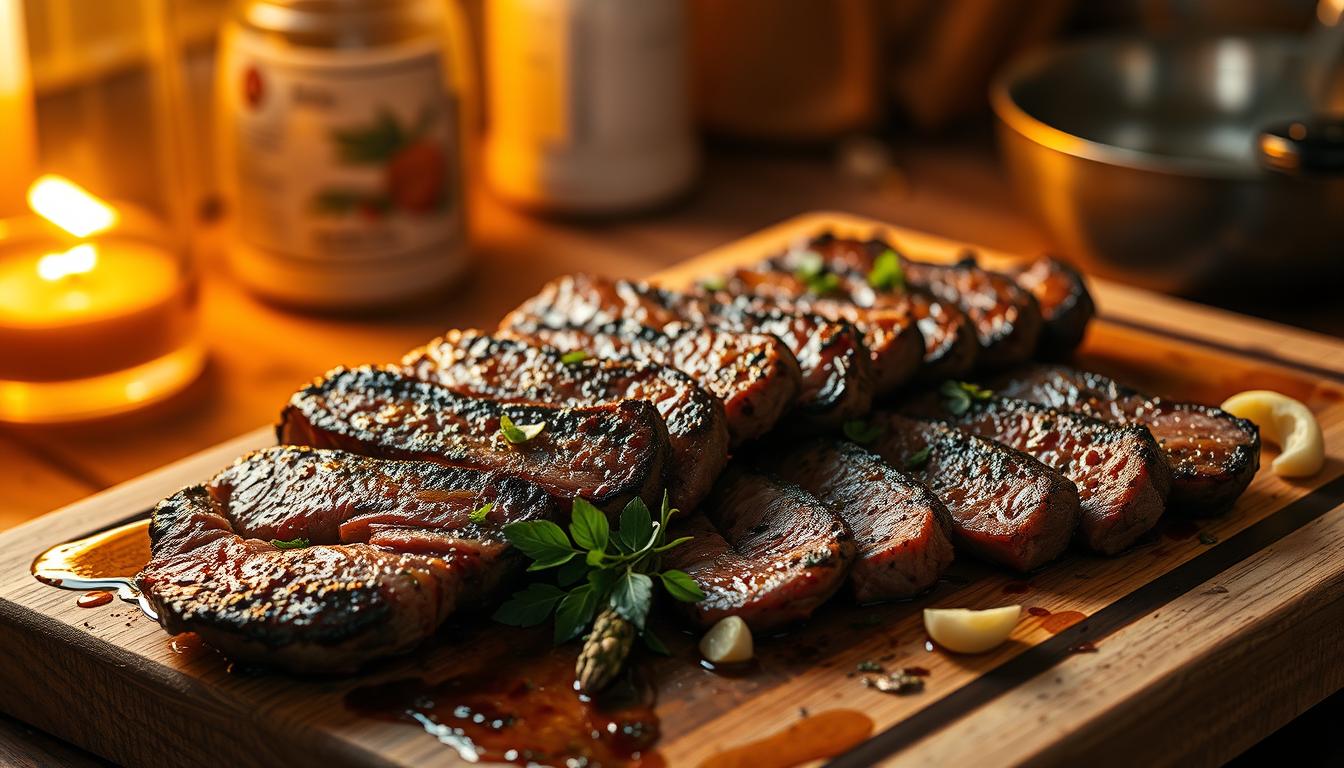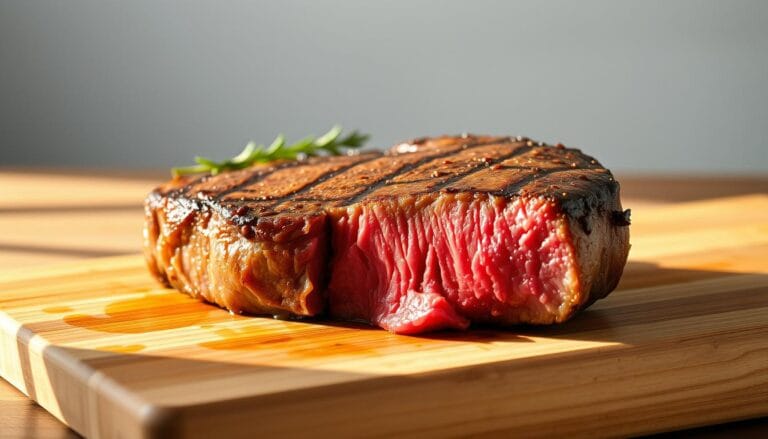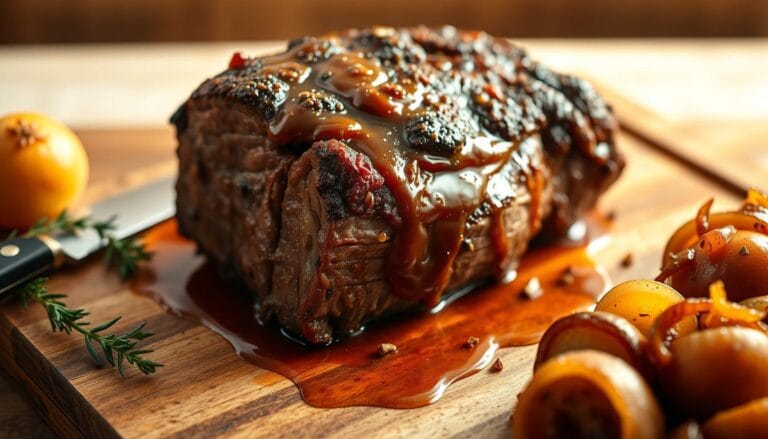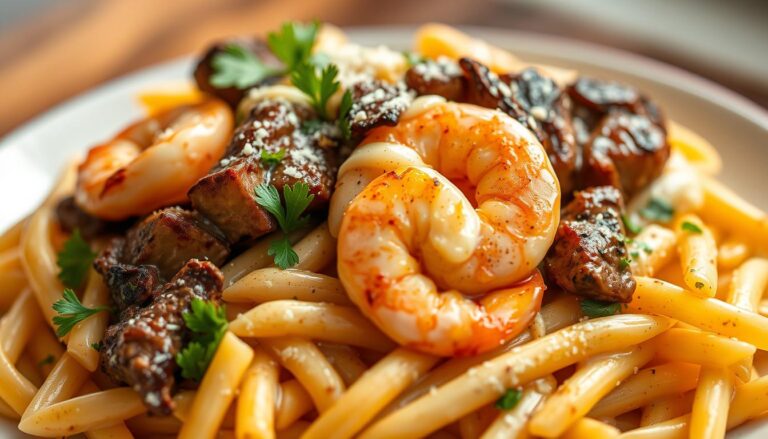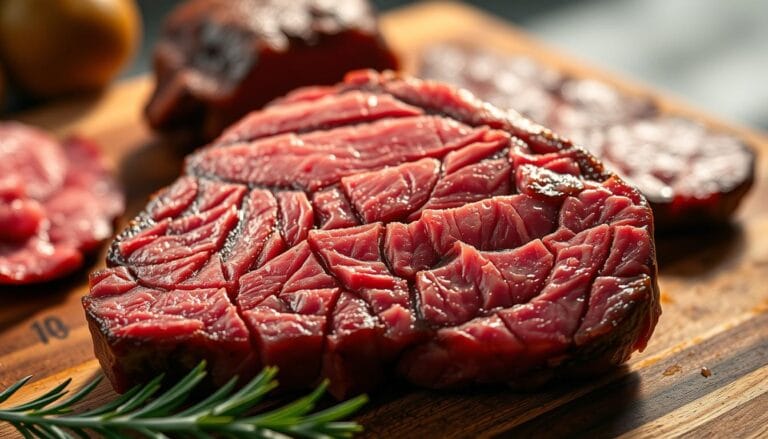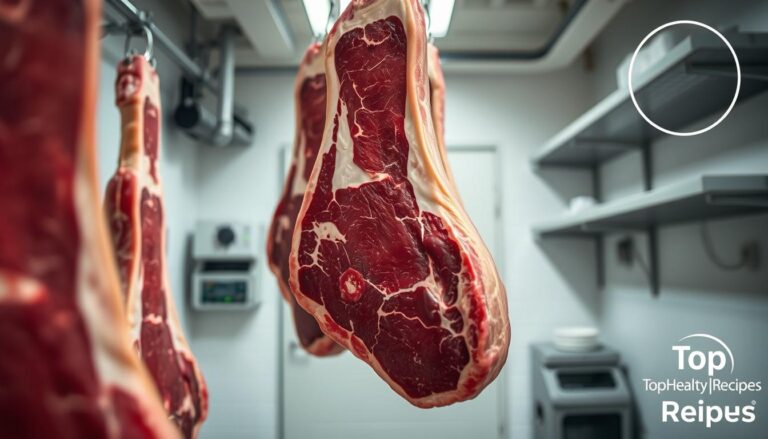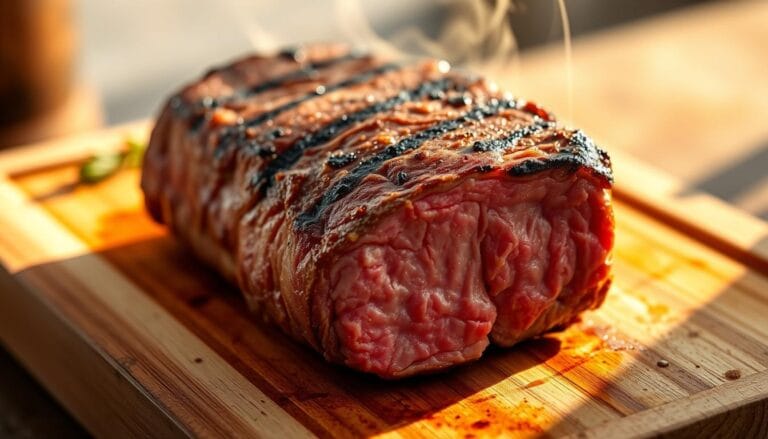How to Prepare Hanger Steak Perfectly for Juicy, Bold Flavor
Table of Contents
How to Prepare Hanger Steak Perfectly for Juicy, Bold Flavor
Cooking the perfect hanger steak can seem tough, even for skilled chefs. This meat was once a secret among butchers but is now loved for its taste and softness. Yet, it can be tricky to cook it just right.
Don’t worry; with the right tips, you can make restaurant-quality results at home. This guide will show you how to pick, cook, and serve hanger steak like a pro. Whether you’re new to cooking or have experience, you’ll learn something new to improve your skills.
Key Takeaways
- Understanding the characteristics of hanger steak
- Selecting the right cut for optimal flavor
- Mastering the cooking techniques for tender results
- Tips for serving and pairing hanger steak
- Achieving restaurant-quality results at home
Understanding Hanger Steak: What Makes It Unique
Hanger steak is a favorite among beef lovers for its deep, beefy taste. To fully enjoy it, knowing its origins and traits is key.
The Cut: Location and Characteristics
Hanger steak is found between the rib and loin, hanging from the diaphragm. Its unique spot gives it a special texture and taste. It has a coarse grain and a central membrane, which can impact its tenderness.
Its location and use make hanger steak tender and full of flavor. Knowing this helps in cooking it right.
Flavor Profile: Why It’s So Popular
Hanger steak’s taste is rich and beefy, with a hint of minerals from its kidney location. This flavor makes it a hit among steak fans. Its marbling adds to its tenderness and taste when cooked right.
When cooked, hanger steak becomes tender and almost velvety. This mix of taste and texture makes it very popular.
Cooking Methods: Best Techniques for Hanger Steak
Cooking hanger steak right brings out its best flavors and textures. Popular methods include grilling, pan-searing, and sous vide. Each method has its benefits, depending on what you prefer and want to achieve.
| Cooking Method | Advantages | Tips |
|---|---|---|
| Grilling | High heat sears the outside, locking in juices. | Preheat grill to high heat, season steak before grilling. |
| Pan-Searing | Creates a crispy crust on the steak. | Use a hot skillet, add a small amount of oil to prevent sticking. |
| Sous Vide | Ensures precise control over cooking temperature. | Season steak before sealing in a bag, cook in a water bath at a controlled temperature. |
Knowing hanger steak’s unique traits and using the right cooking methods can make your meal unforgettable. It can be a highlight of any meal.
Choosing the Right Hanger Steak
Before you can cook a mouth-watering hanger steak, you need to know what to look for when buying it. Choosing the right piece of meat is key for a delicious meal. You need to understand quality indicators, the differences between grass-fed and grain-fed options, and whether to choose fresh or frozen steak.
Quality Matters: What to Look For
When it comes to hanger steak, quality is key. Look for cuts with good marbling for tenderness and flavor. Also, make sure the central membrane is properly trimmed for better texture and taste.
The color of the steak is another sign of freshness. A bright red color means it’s fresh. A thicker steak cooks more evenly, helping you get your desired doneness.
Grass-Fed vs. Grain-Fed: Which Is Better?
The debate between grass-fed and grain-fed beef is ongoing. Grass-fed hanger steak is leaner with a robust flavor. Grain-fed steak is more marbled, making it tender and juicy.
Your choice depends on taste, texture, and dietary considerations. Grass-fed beef is more sustainable, but grain-fed offers a richer taste.
Fresh vs. Frozen: Unpacking the Options
The choice between fresh and frozen hanger steak depends on availability and cooking plans. Fresh steak is best for immediate cooking. Frozen steak is good if it’s been frozen properly.
When choosing frozen steak, look for individually wrapped and quickly frozen options. Proper thawing and handling can make frozen steak a great alternative to fresh.
Preparing Hanger Steak for Cooking
To get the most out of your hanger steak, proper preparation is key. The steps you take before cooking can greatly affect the taste and texture of your steak.
Thawing: How to Do It Right
If your hanger steak is frozen, thawing it first is essential. The safest way is to thaw it in the fridge, letting it thaw slowly over several hours or overnight. This keeps the steak’s quality intact.
For a quicker thaw, you can use cold water. Change the water every 30 minutes to keep it cold. Never thaw at room temperature, as it can cause bacterial growth.
Dry Brining: Enhancing Flavor
Dry brining involves rubbing your steak with salt and letting it sit in the fridge before cooking. This method boosts the steak’s flavor and keeps it moist. To dry brine, sprinkle both sides with kosher salt and let it sit uncovered in the fridge for at least an hour or overnight.
Tips for dry brining: Use kosher salt for its mild flavor and texture. Let the steak sit for at least an hour, but overnight is best for more intense flavor.
Marinades: Tips for the Best Mix
Marinades can add a lot of flavor to your hanger steak. A good marinade has a balance of acidity, oil, and seasonings. Acidic ingredients like vinegar or citrus juice break down proteins, while oil keeps the steak moist.
For a simple marinade, mix olive oil, soy sauce, garlic, and a splash of lemon juice. Place your steak in a zip-top bag, pour the marinade over it, and refrigerate for at least 2 hours or overnight.
Avoid over-acidic marinades, as they can make the steak mushy. Also, be mindful of the marinating time; too long can result in an overly salty or acidic taste.
- Use a balance of acidic ingredients and oil.
- Marinate for at least 2 hours, but no more than 24 hours.
- Keep the steak refrigerated during marinating.
Seasoning Your Hanger Steak
To get the most out of your hanger steak, seasoning is key. It’s not just about adding flavor. It’s about making the steak’s natural taste shine without being too strong.
Essential Seasonings: Salt and Pepper
The base of great steak seasoning is salt and pepper. Salt brings out the flavor, and pepper adds a nice touch. Kosher salt is better than table salt because it’s coarser and tastes cleaner. Use 1-2 teaspoons of kosher salt per pound of steak, depending on how salty you like it.
For pepper, use freshly ground black pepper. You can add a lot, but remember, it’s all about balance. You want the seasoning to enhance the steak’s taste, not overpower it.
Advanced Seasoning Ideas: Going Beyond Basics
While salt and pepper are must-haves, you can also use other seasonings. Try garlic powder, rosemary, thyme, or paprika for more depth. Garlic powder adds a savory taste, while rosemary and thyme give a herby flavor that goes well with hanger steak.
For a spicy twist, add a bit of paprika or chili powder. The goal is to find the mix that you enjoy the most.
Timing: When to Season for Optimal Taste
When you season your hanger steak matters a lot. Seasoning right before cooking is common, but letting it sit can make flavors penetrate deeper, like salt.
For dry brining, sprinkle salt 1-2 hours before cooking. For other seasonings, add them just before cooking. But don’t overdo it, as too much seasoning can be overwhelming.
Cooking Methods for Hanger Steak
Hanger steak is great for many cooking methods. You can get a perfect sear or cook it just right. There’s a method for everyone.
Grilling: Achieving Perfect Marks
Grilling is a favorite for hanger steak. It gives a nice char on the outside and keeps the inside juicy. Preheat your grill to 450°F to 500°F for the best results.
Tips for Grilling:
- Pat the steak dry with paper towels before grilling to enhance browning.
- Use a cast-iron or stainless steel grill grate for better heat retention.
- Grill for 4-5 minutes per side, or until you achieve your desired level of doneness.
Pan-Searing: Getting That Crust
Pan-searing is great for a flavorful crust. Use a skillet that can handle high heat, like cast iron or stainless steel. Heat oil with a high smoke point, like avocado oil, until it smokes.
Tips for Pan-Searing:
- Sear the steak for 2-3 minutes per side, or until a nice crust forms.
- Finish cooking the steak in the oven to your desired level of doneness.
- Let the steak rest for a few minutes before slicing.
Sous Vide: Cooking with Precision
Sous vide cooking is precise, ensuring your steak is cooked just right. Season the steak, then seal it in a sous vide bag. Cook in a water bath at 130°F to 135°F for medium-rare.
Tips for Sous Vide:
- Use a sous vide machine to maintain a precise temperature.
- Cook for 1-2 hours, depending on the thickness of the steak.
- Finish with a quick sear in a hot pan for added texture.
Broiling: An Alternative Approach
Broiling is a good choice when grilling isn’t possible. Preheat your broiler and place the steak on a broiler pan. Cook for 4-5 minutes per side, or until done.
Tips for Broiling:
- Use a broiler pan to allow for air circulation around the steak.
- Keep an eye on the steak, as broiling can quickly go from perfect to overcooked.
| Cooking Method | Temperature | Cooking Time |
|---|---|---|
| Grilling | 450°F – 500°F | 4-5 minutes per side |
| Pan-Searing | High heat | 2-3 minutes per side |
| Sous Vide | 130°F – 135°F | 1-2 hours |
| Broiling | High heat | 4-5 minutes per side |
How to Tell When Hanger Steak is Done
Knowing when your hanger steak is cooked just right is essential. It lets you enjoy its full flavor and tenderness. To get it right, you need to understand how to check it accurately.
Cooking Temperatures: What to Aim For
The internal temperature of the steak tells you its doneness. For hanger steak, aim for these temperatures:
| Doneness Level | Internal Temperature |
|---|---|
| Rare | 125°F |
| Medium-Rare | 130-135°F |
| Medium | 140-145°F |
| Medium-Well | 150-155°F |
Hanger steak tastes best at medium-rare to medium. This ensures tenderness and flavor.
The Touch Test: Knowing Doneness by Feel
The touch test is a classic way to check steak doneness. It compares the meat’s feel to your hand. A rare steak feels like the soft part of your palm when your hand is relaxed.
As you tense your hand, the steak feels firmer, showing different doneness levels.
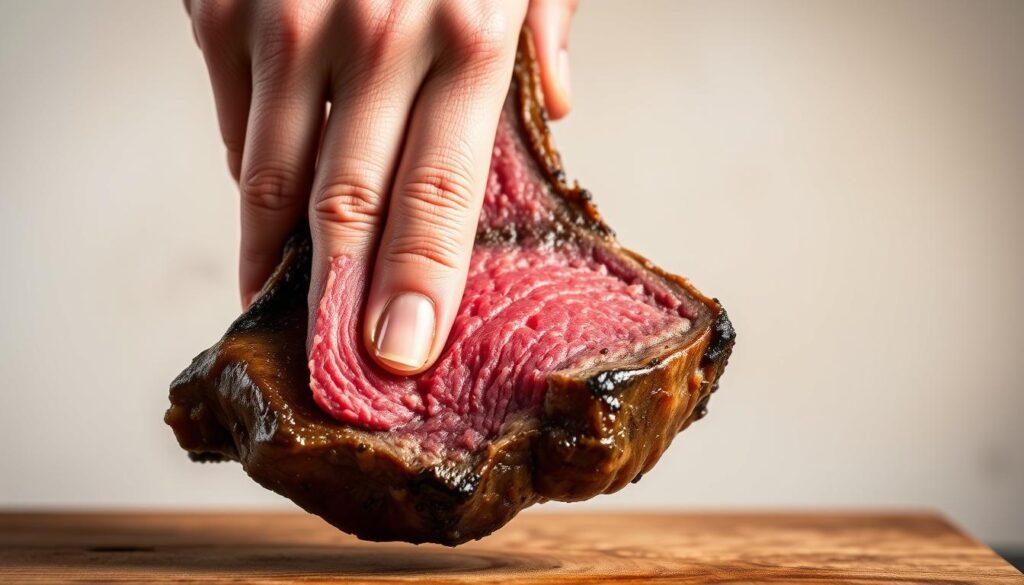
Using a Meat Thermometer: A Foolproof Method
For exact results, use an instant-read digital thermometer. Stick it into the thickest part of the steak, avoiding the center. This gives you the internal temperature, ensuring your steak is cooked perfectly.
Remember carryover cooking. The steak’s temperature rises after it’s off the heat. This helps you cook it to perfection.
Letting Your Hanger Steak Rest
After cooking your hanger steak to perfection, the next step is letting it rest. This is key for the juices to spread evenly. It makes sure your steak stays moist and flavorful.
The Science Behind Resting
When you cook hanger steak, the heat tightens the proteins. This pushes juices to the surface. If you cut it right away, these juices will spill out, making the steak dry.
Resting lets the proteins relax. This spreads the juices evenly through the meat. You get a tender and juicy steak.
Optimal Resting Time
The resting time for hanger steak depends on its thickness and cooking method. Usually, 5-10 minutes is best. To keep the steak warm without steaming, cover it with foil.
| Steak Thickness | Recommended Resting Time |
|---|---|
| 1 inch | 5 minutes |
| 1.5 inches | 7-8 minutes |
| 2 inches | 10 minutes |
Slicing Techniques Post-Rest
After resting, it’s time to slice your steak. To keep it tender, cut against the grain. This can be tricky with hanger steak, but it’s important for the best texture.
Slice it to a thickness that’s tender but also satisfying to bite into.
By following these steps, your hanger steak will be perfectly cooked and presented. It will show off its natural flavors and textures.
Serving Suggestions for Hanger Steak
A well-cooked hanger steak deserves impressive sides and sauces. These can make your meal unforgettable. Pair your steak with flavors and textures that complement it well.
Pairing Sides: What Complements Your Steak
Choosing the right sides is key. The hanger steak’s bold flavor needs balance. Try roasted potatoes and grilled vegetables for a classic choice.
For something new, pair it with bitter greens or a hearty grain salad. These can contrast the meat’s richness beautifully.
Sauces: Elevating Flavors with Accompaniments
Sauces can really boost your steak’s taste. A chimichurri made with parsley, oregano, garlic, and lemon is a great choice. It adds a fresh, herby flavor.
For a deeper taste, a red wine reduction is perfect. Or, a compound butter can melt over the steak, adding a luxurious touch.
Presentation: Making Your Dish Appealing
How you present your dish matters a lot. Arrange your steak and sides nicely. Add fresh herbs or microgreens for color.
Make sure your steak is sliced right and served at the best temperature. This will enhance both flavor and tenderness.
With these tips, your hanger steak can become a memorable meal. It will impress your guests and satisfy your taste buds.
Creative Hanger Steak Recipes to Try
Mastering hanger steak basics is just the start. Now, let’s dive into creative recipes that highlight its versatility. Whether you’re planning an elegant dinner or a quick weeknight meal, hanger steak fits the bill. Here are some exciting recipes to try:
Classic Steak Frites: A Timeless Pairing
Steak frites is a timeless favorite. It pairs perfectly cooked hanger steak with crispy fries. To make this dish, you’ll need:
- 1 hanger steak
- 2 pounds potatoes, cut into fries
- Vegetable oil for frying
- Salt and pepper to taste
- Optional: garlic, thyme, or other seasonings of your choice
First, preheat your grill or skillet to cook the hanger steak to your liking. While the steak cooks, prepare the fries. Soak them in cold water, then dry and fry until crispy.
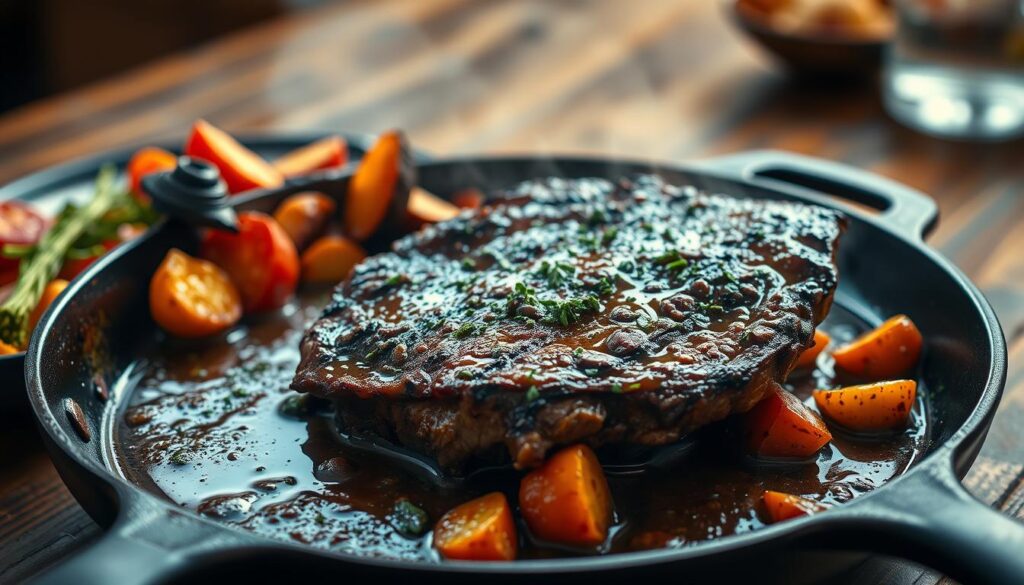
Tacos: Adding a Twist to Traditional
Try hanger steak in tacos for a casual, flavorful twist. Marinate the steak in lime juice, chili powder, and cumin. Grill or pan-fry it to your liking. Top it with your favorite toppings, such as:
| Topping | Description |
|---|---|
| Sliced avocado | Adds creamy texture |
| Pico de gallo | Provides a burst of fresh flavor |
| Sour cream | Offers a tangy contrast |
Salad: Lightening It Up with Greens
For a lighter option, slice cooked hanger steak thinly. Serve it on a bed of seasonal greens. Choose a dressing and garnishes like cherry tomatoes or blue cheese for a balanced meal.
Tips for a great salad: Mix different greens like arugula and spinach. Add crunch with toasted nuts or seeds.
Common Mistakes to Avoid When Cooking Hanger Steak
Cooking hanger steak right is all about knowing what can go wrong. Even skilled cooks can make mistakes that ruin the steak. By avoiding these errors, you can make sure your hanger steak is tender, tasty, and perfectly cooked.
Overcooking: The Number One Pitfall
Overcooking hanger steak makes it tough and unpleasant. It’s important to cook it just right. Use a meat thermometer to get the perfect internal temperature. For medium-rare, aim for 130°F – 135°F (54°C – 57°C). Remember, the steak will cook a bit more after it’s off the heat.
| Doneness Level | Internal Temperature (°F) | Internal Temperature (°C) |
|---|---|---|
| Rare | 120-125 | 49-52 |
| Medium Rare | 130-135 | 54-57 |
| Medium | 140-145 | 60-63 |
Skipping the Resting Period: What You Miss
Not letting the steak rest can make it less tender and flavorful. Resting allows the juices to spread, making the steak better. Let it rest for at least 5-10 minutes before slicing. This patience will make your steak taste amazing.
Not Trimming Properly: The Impact on Taste
Trimming the central membrane and silver skin is key for hanger steak. Not doing this can make the steak chewy. To trim right, find the membrane and cut it out carefully with a sharp knife. This small step makes a big difference in taste and texture.
Tips for Trimming: Use a sharp knife and be patient. Removing the membrane makes the steak tender and lets seasonings soak in better.
Leftover Hanger Steak Ideas
Don’t let leftover hanger steak go to waste. Turn it into a new culinary masterpiece. With a little creativity, you can enjoy your hanger steak in various delicious forms.
Reheating: Keeping It Tender
Reheating hanger steak needs care to keep it tender. Try the low-and-slow oven technique. Place the steak in a low-temperature oven (around 250°F) for a short time. This method keeps the steak moist.
Or, use a skillet with oil or butter to reheat the steak. This way, it heats evenly without overcooking.
To improve reheating, add broth or sauce to the pan. This helps keep the steak moist, which is great for reheating a lot of steak.
Sandwiches: Delicious Lunch Options
Make sandwiches with leftover hanger steak for a tasty lunch. Try a Vietnamese banh mi. Slice the steak thinly and serve it on a crispy baguette with pickled veggies, herbs, and chili sauce.
Or, go for an Italian-style panini. Use arugula, mozzarella, and balsamic glaze for a delightful sandwich.
- Slice the steak against the grain for tenderness.
- Add complementary condiments and toppings.
- Choose a bread that complements the filling, such as a crusty baguette or ciabatta.
Stir-Fry: Quick Dinner Solutions
Make a stir-fry with leftover hanger steak for a quick dinner. Slice the steak into thin strips. Stir-fry it with your favorite veggies (like bell peppers, broccoli, or carrots) and a sauce (such as soy sauce, oyster sauce, or garlic and ginger).
The secret to a great stir-fry is cooking fast over high heat. This keeps the steak tender and the veggies crunchy.
Frequently Asked Questions About Hanger Steak
Whether you’re a seasoned chef or new to cooking, knowing about hanger steak is essential. It’s important to understand this cut well to cook it perfectly. Many questions may come up as you explore its possibilities.
Similar Cuts to Hanger Steak
If hanger steak is hard to find, consider other cuts like flank steak, skirt steak, and flat iron steak. Each has its own taste and texture. For example, flank steak is leaner and might need more marinating. Flat iron steak is as tender as hanger steak.
Using Hanger Steak for Ground Meat
Hanger steak is great when cooked whole for its tenderness and flavor. But, it’s not the best choice for ground meat because of its high value. If you have leftover or a piece not good for whole cooking, grinding it is a smart way to use it.
Storing Leftover Hanger Steak
Storing leftover hanger steak right is key to keeping its quality. Cool cooked steak before refrigerating it in a sealed container. It can stay in the fridge for up to 3 days. For longer, freeze it, lasting months. Wrap it in plastic or foil and put it in a freezer-safe bag.
By answering these common questions, you’ll feel more confident with hanger steak. Whether it’s your first time or you’re a pro, you’ll improve your cooking skills.
Conclusion: Mastering Hanger Steak Cooking at Home
Cooking hanger steak to perfection is a skill you can learn. It takes practice and patience. By knowing the cut, picking the right steak, and using the right cooking methods, you can make a delicious meal.
Key Takeaways
To cook hanger steak well, choose a high-quality steak. Cook it to the right temperature and let it rest before slicing. This is key to getting the best flavor and texture.
Try different seasonings and cooking ways to make your own hanger steak dish. Whether grilling, pan-searing, or using a sous vide machine, the secret is knowing how to cook it just right.
Exploring New Flavors
As you get better at cooking hanger steak, try new flavors and sides. From classic steak frites to creative tacos and salads, hanger steak is versatile. With practice, you’ll cook hanger steak perfectly, impressing everyone with your cooking skills.
FAQ
What cuts are similar to hanger steak?
Can I use hanger steak for ground meat?
How do I store leftover hanger steak?
How to prepare hanger steak?
How to cook hanger steak?
What are some recipes for hanger steak?
For more cooking tips, stay connected with us. We also recommend the cookbook Skinnytaste Simple: Easy, Healthy Recipes with 7 Ingredients or Fewer
For more Recipes about Steak ?
Did You try our recipe ?
There are no reviews yet. Be the first one to write one.
